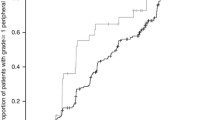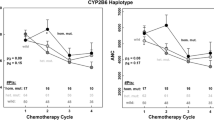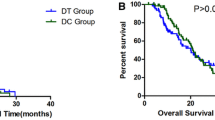Abstract
Paclitaxel is one of the most frequently used chemotherapeutic agents for the treatment of breast cancer patients. Using a candidate gene approach, we hypothesized that polymorphisms in genes relevant to the metabolism and transport of paclitaxel are associated with treatment efficacy and toxicity. Patient and tumor characteristics and treatment outcomes were collected prospectively for breast cancer patients treated with paclitaxel-containing regimens in the neoadjuvant setting. Treatment response was measured before and after each phase of treatment by clinical tumor measurement and categorized according to RECIST criteria, while toxicity data were collected from physician notes. The primary endpoint was achievement of clinical complete response (cCR) and secondary endpoints included clinical response rate (complete response + partial response) and grade 3+ peripheral neuropathy. The genotypes and haplotypes assessed were CYP1B1*3, CYP2C8*3, CYP3A4*1B/CYP3A5*3C, and ABCB1*2. A total of 111 patients were included in this study. Overall, cCR was 30.1 % to the paclitaxel component. CYP2C8*3 carriers (23/111, 20.7 %) had higher rates of cCR (55 % vs. 23 %; OR = 3.92 [95 % CI: 1.46–10.48], corrected p = 0.046). In the secondary toxicity analysis, we observed a trend toward greater risk of severe neuropathy (22 % vs. 8 %; OR = 3.13 [95 % CI: 0.89–11.01], uncorrected p = 0.075) in subjects carrying the CYP2C8*3 variant. Other polymorphisms interrogated were not significantly associated with response or toxicity. Patients carrying CYP2C8*3 are more likely to achieve clinical complete response from neoadjuvant paclitaxel treatment, but may also be at increased risk of experiencing severe peripheral neurotoxicity.

Similar content being viewed by others
References
Henningsson A, Sparreboom A, Sandström M, Freijs A, Larsson R, Bergh J, Nygren P, Karlsson MO (2003) Population pharmacokinetic modelling of unbound and total plasma concentrations of paclitaxel in cancer patients. Eur J Cancer 39(8):1105–1114
Sparano JA, Wang M, Martino S, Jones V, Perez EA, Saphner T, Wolff AC, Sledge GW, Wood WC, Davidson NE (2008) Weekly paclitaxel in the adjuvant treatment of breast cancer. N Engl J Med 358(16):1663–1671
Di Leo A, Gomez HL, Aziz Z, Zvirbule Z, Bines J, Arbushites MC, Guerrera SF, Koehler M, Oliva C, Stein SH, Williams LS, Dering J, Finn RS, Press MF (2008) Phase III, double-blind, randomized study comparing lapatinib plus paclitaxel with placebo plus paclitaxel as first-line treatment for metastatic breast cancer. J Clin Oncol 26(34):5544–5552
McLeod HL, Evans WE (2001) Pharmacogenomics: unlocking the human genome for better drug therapy. Annu Rev Pharmacol Toxicol 41:101–121
Hoskins JM, Goldberg RM, Qu P, Ibrahim JG, McLeod HL (2007) UGT1A1*28 genotype and irinotecan-induced neutropenia: dose matters. J Natl Cancer Inst 99(17):1290–1295
Hu Z, Yu Q, Zhao Y (2010) Dose-dependent association between UGT1A1∗28 polymorphism and irinotecan-induced diarrhoea: a meta-analysis. Eur J Cancer 46(10):1856–1865
Klein TE, Altman RB, Eriksson N, Gage BF, Kimmel SE, International Warfarin Pharmacogenetics Consortium et al (2009) Estimation of the warfarin dose with clinical and pharmacogenetic data. N Engl J Med 360(8):753–764
Chang H, Rha SY, Jeung HC, Im CK, Noh SH, Kim JJ, Chung HC (2010) Association of the ABCB1 3435C>T polymorphism and treatment outcomes in advanced gastric cancer patients treated with paclitaxel-based chemotherapy. Oncol Rep 23(1):271–278
Chang H, Rha SY, Jeung H-, Im C-, Ahn JB, Kwon WS, Yoo NC, Roh JK, Chung HC (2009) Association of the ABCB1 gene polymorphisms 2677G>T/A and 3435C>T with clinical outcomes of paclitaxel monotherapy in metastatic breast cancer patients. Ann Oncol 20(2):272–277
Green H, Soderkvist P, Rosenberg P, Horvath G, Peterson C (2006) Mdr-1 single nucleotide polymorphisms in ovarian cancer tissue: G2677T/A correlates with response to paclitaxel chemotherapy. Clin Cancer Res 12(3):854–859
Leskela S, Jara C, Leandro-Garcia L, Martinez A, Garcia-Donas J, Hernando S, Hurtado A, Vicario JCC, Montero-Conde C, Landa I, Lopez-Jimenez E, Cascon A, Milne RL, Robeldo M, Rodriguez-Antona C (2011) Polymorphisms in cytochromes P450 2C8 and 3A5 are associated with paclitaxel neurotoxicity. Pharmacogenomics J 11(2):121–129
Petros WP, Hopkins PJ, Spruill S, Broadwater G, Vredenburgh JJ, Colvin OM, Peters WP, Jones RB, Hall J, Marks JR (2005) Associations between drug metabolism genotype, chemotherapy pharmacokinetics, and overall survival in patients with breast cancer. J Clin Oncol 23(25):6117–6125
Marsh S, Somlo G, Li X, Frankel P, King CR, Shannon WD, McLeod HL, Synold TW (2007) Pharmacogenetic analysis of paclitaxel transport and metabolism genes in breast cancer. Pharmacogenomics J 7(5):362–365
Kroetz DL, Baldwin RM, Owzar K, Jiang C, Zembutsu H, Kubo M, Nakamura Y, Shulman LN, Ratain MJ, Cancer and Leukemia Group B. (2010) Inherited genetic variation in EPHA5, FGD4, and NRDG1 and paclitaxel (P)-induced peripheral neuropathy (PN): results from a genome-wide association study (GWAS) in CALGB 40101. ASCO Meeting Abstracts. 2010 June 14;28(15 Suppl):3021
Schneider BP, Li L, Miller K, Flockhart D, Radovich M, Hancock BA, Kassem N, Forourd T, Koller DL, Badve SS, Li Z, Partridge AH, O’Neill AM, Sparano JA, Dang CT, Northfelt DW, Smith ML, Railey E, Sledge GW (2011) Genetic associations with taxane-induced neuropathy by a genome-wide association study (GWAS) in E5103. ASCO Meeting Abstracts. 2011 June 09;29(15_suppl):1000
Rizzo R, Spaggiari F, Indelli M, Lelli G, Baricordi O, Rimessi P, Ferlini A (2010) Association of CYP1B1 with hypersensitivity induced by taxane therapy in breast cancer patients. Breast Cancer Res Treat 124(2):593–598
Sissung TM, Mross K, Steinberg SM, Behringer D, Figg WD, Sparreboom A, Mielke S (2006) Association of ABCB1 genotypes with paclitaxel-mediated peripheral neuropathy and neutropenia. Eur J Cancer 42(17):2893–2896
Sørlie T, Perou CM, Tibshirani R, Aas T, Geisler S, Johnsen H, Hastie T, Eisen MB, van de Rijn M, Jeffrey SS, Thorsen T, Quist H, Matese JC, Brown PO, Botstein D, Lenning PE, Borresen-Dale A (2001) Gene expression patterns of breast carcinomas distinguish tumor subclasses with clinical implications. Proc Natl Acad Sci USA 98(19):10869–10874
Eley JW, Hill HA, Chen VW, Austin DF, Wesley MN, Muss HB, Greenberg RS, Coates RJ, Correa P, Redmond CK (1994) Racial differences in survival from breast cancer. Results of the National Cancer Institute Black/White Cancer Survival Study. JAMA 272(12):947–954
Eisenhauer EA, Therasse P, Bogaerts J, Schwartz LH, Sargent D, Ford R, Dancey J, Arbuck S, Gwyther S, Mooney M, Rubinstein L, Shankar L, Dodd L, Kaplan R, Lacombe D, Verweij J (2009) New response evaluation criteria in solid tumours: revised RECIST guideline (version 1.1). Eur J Cancer 45(2):228–247
Common Terminology Criteria for Adverse Events (CTCAE) version 4.0. U.S. Department of Health and Human Services, National Institutes of Health, National Cancer Institute; 2010 June 14, 2010
Marsh S, King CR, Garsa AA, McLeod HL (2005) Pyrosequencing of clinically relevant polymorphisms. Methods Mol Biol 311:97–114
Rose CM, Marsh S, Ameyaw MM, McLeod HL (2003) Pharmacogenetic analysis of clinically relevant genetic polymorphisms. Methods Mol Med 85:225–237
Stephens M, Donnelly P (2003) A comparison of bayesian methods for haplotype reconstruction from population genotype data. Am J Hum Genet 73(5):1162–1169
Stephens M, Smith NJ, Donnelly P (2001) A new statistical method for haplotype reconstruction from population data. Am J Hum Genet 68(4):978–989
Baker SD, Verweij J, Cusatis GA, van Schaik R, Marsh S, Orwick SJ, Franke RM, Hu S, Schuetz EG, Lamba V, Messersmith WA, Wolff AC, Carducci MA, Sparreboom A (2008) Pharmacogenetic pathway analysis of docetaxel elimination. Clin Pharmacol Ther 85(2):155–163
Sissung TM, Baum CE, Deeken J, Price DK, Aragon-Ching J, Steinberg SM, Dahut W, Sparreboom A, Figg WD (2008) ABCB1 genetic variation influences the toxicity and clinical outcome of patients with androgen-independent prostate cancer treated with docetaxel. Clin Cancer Res 14(14):4543–4549
Barnholtz-Sloan JS, de Andrade M, Chakraborty R (2001) The impact of population admixture on traditional linkage analysis. Ethn Dis 11(3):519–531
Garsa A, McLeod H, Marsh S (2005) CYP3A4 and CYP3A5 genotyping by pyrosequencing. BMC Med Genet 6(1):19
International HapMap Consortium (2003) The international HapMap project. Nature 426(6968):789–796
NCBI (2010) NCBI entrez SNP database. Available from: http://www.ncbi.nlm.nih.gov/sites/entrez?db=snp. Accessed Oct 05, 2008
Cance WG, Carey LA, Calvo BF, Sartor C, Sawyer L, Moore DT, Rosenman J, Ollila DW, Graham M (2002) Long-term outcome of neoadjuvant therapy for locally advanced breast carcinoma: effective clinical downstaging allows breast preservation and predicts outstanding local control and survival. Ann Surg 236(3):295–302 Discussion: 302–303
Carey LA, Metzger R, Dees EC, Collichio F, Sartor CI, Ollila DW, Klauber-DeMore N, Halle J, Sawyer L, Moore DT, Graham ML (2005) American Joint Committee on Cancer Tumor–Node–Metastasis stage after neoadjuvant chemotherapy and breast cancer outcome. J Natl Cancer Inst 97(15):1137–1142
Fisher B, Bryant J, Wolmark N, Mamounas E, Brown A, Fisher ER, Wickerham DL, Begovic M, DeCillis A, Robidoux A, Margolese RG, Cruz AB, Hoehn JL, Lees AW, Dimitrov NV, Bear HD (1998) Effect of preoperative chemotherapy on the outcome of women with operable breast cancer. J Clin Oncol 16(8):2672–2685
Zheng S, Zhang BL, Zhang RZ, Yang JL, Zou SM, Xue LY, Luo W, Yuan YL, Lu N (2010) Differences between clinical response and pathologic response of breast cancer after neoadjuvant chemotherapy. Zhonghua Bing Li Xue Za Zhi 39(11):734–738 in Chinese
Marsh S, Paul J, King CR, Gifford G, McLeod HL, Brown R (2007) Pharmacogenetic assessment of toxicity and outcome after platinum plus taxane chemotherapy in ovarian cancer: the Scottish randomised trial in ovarian cancer. J Clin Oncol 25(29):4528–4535
Bergmann TK, Gréen H, Brasch-Andersen C, Mirza M, Herrstedt J, Hølund B, du Bois A, Damkier P, Vach W, Brosen K, Peterson C (2011) Retrospective study of the impact of pharmacogenetic variants on paclitaxel toxicity and survival in patients with ovarian cancer. Eur J Clin Pharmacol 67(7):693–700
Sparreboom A, Huizing MT, Boesen JJB, Nooijen WJ, Beijnen JH, Tellingen OV (1995) Isolation, purification, and biological activity of mono- and dihydroxylated paclitaxel metabolites from human feces. Cancer Chemother Pharmacol 36(4):299–304
Mielke S, Sparreboom A, Steinberg SM, Gelderblom H, Unger C, Behringer D, Mross K (2005) Association of paclitaxel pharmacokinetics with the development of peripheral neuropathy in patients with advanced cancer. Clin Cancer Res 11(13):4843–4850
de Jonge ME, van den Bongard HJGD, Huitema ADR, Mathôt RAA, Rosing H, Baas P, van Zandwijk N, Beijnen JH, Schellens JHM (2004) Bayesian pharmacokinetically guided dosing of paclitaxel in patients with non-small cell lung cancer. Clin Cancer Res 10(7):2237–2244
van Gerven JMA, Moll JWB, van den Bent MJ, Bontenbal M, van der Burg MEL, Verweij J, Vecht CJ (1994) Paclitaxel (taxol) induces cumulative mild neurotoxicity. Eur J Cancer 30(8):1074–1077
Rowbotham SE, Boddy AV, Redfern CPF, Veal GJ, Daly AK (2010) Relevance of nonsynonymous CYP2C8 polymorphisms to 13-cis retinoic acid and paclitaxel hydroxylation. Drug Metab Dispos 38(8):1261–1266
Soyama A, Saito Y, Hanioka N, Murayama N, Nakajima O, Katori N, Ishida S, Kimie S, Ozawa S, Sawada J (2001) Non-synonymous single nucleotide alterations found in the CYP2C8 gene result in reduced in vitro paclitaxel metabolism. Biol Pharm Bull 24(12):1427–1430
Bahadur N, Leathart JBS, Mutch E, Steimel-Crespi D, Dunn SA, Gilissen R, Houdt JV, Hendrickx J, Mannens G, Bohets H, Williams FM, Armstrong M, Crespi CL, Daly AK (2002) CYP2C8 polymorphisms in caucasians and their relationship with paclitaxel 6α-hydroxylase activity in human liver microsomes. Biochem Pharmacol 64(11):1579–1589
Dai D, Zeldin DC, Blaisdell JA, Chanas B, Coulter SJ, Ghanayem BI, Goldstein JA (2001) Polymorphisms in human CYP2C8 decrease metabolism of the anticancer drug paclitaxel and arachidonic acid. Pharmacogenetics 11(7):597–607
Bergmann TK, Brasch-Andersen C, Green H, Mirza M, Pedersen RS, Nielsen F, Skougaard K, Wihl J, Keldsen N, Damkier P, Friberg LE, Peterson C, Vach W, Karlsson MO, Brosen K (2011) Impact of CYP2C8*3 on paclitaxel clearance: A population pharmacokinetic and pharmacogenomic study in 93 patients with ovarian cancer. Pharmacogenomics J 11(2):113–120
Gao Y, Liu D, Wang H, Zhu J, Chen C (2010) Functional characterization of five CYP2C8 variants and prediction of CYP2C8 genotype-dependent effects on in vitro and in vivo drug–drug interactions. Xenobiotica 40(7):467–475
Speed WC, Kang SP, Tuck DP, Harris LN, Kidd KK (2009) Global variation in CYP2C8–CYP2C9 functional haplotypes. Pharmacogenomics J 9(4):283–290
Seidman AD, Berry D, Cirrincione C, Harris L, Muss H, Marcom PK, Gipson G, Burstein H, Lake D, Shapiro CL, Ungaro P, Norton L, Winer E, Hudis C (2008) Randomized phase III trial of weekly compared with every-3-weeks paclitaxel for metastatic breast cancer, with trastuzumab for all HER-2 overexpressors and random assignment to trastuzumab or not in HER-2 nonoverexpressors: final results of cancer and leukemia group B protocol 9840. J Clin Oncol 26(10):1642–1649
Henningsson A, Marsh S, Loos WJ, Karlsson MO, Garsa A, Mross K, Mielke S, Vigano L, Locatelli A, Verweij J, Sparreboom A, McLeod HL (2005) Association of CYP2C8, CYP3A4, CYP3A5, and ABCB1 polymorphisms with the pharmacokinetics of paclitaxel. Clin Cancer Res 11(22):8097–8104
Gandara DR, Kawaguchi T, Crowley J, Moon J, Furuse K, Kawahara M, Teramukai S, Ohe Y, Kubota K, Williamsoon ST, Gautschi O, Lenz HJ, McLeod HL, Lara PN, Coltman CA, Fukuoka M, Saijo N, Fukushima M, Mack PC (2009) Japanese–US common-arm analysis of paclitaxel plus carboplatin in advanced non-small-cell lung cancer: a model for assessing population-related pharmacogenomics. J Clin Oncol 27(21):3540–3546
Bournique B, Lemarié A (2002) Docetaxel (taxotere) is not metabolized by recombinant human CYP1B1 in vitro, but acts as an effector of this isozyme. Drug Metab Dispos 30(11):1149–1152
Sissung TM, Danesi R, Price DK, Steinberg SM, de Wit R, Zahid M, Gaikwad N, Cavalieri E, Dahut WL, Sackett DL, Figg WD, Sparreboom A (2008) Association of the CYP1B1*3 allele with survival in patients with prostate cancer receiving docetaxel. Mol Cancer Ther 7(1):19–26
Pastina I, Giovannetti E, Chioni A, Sissung TM, Crea F, Orlandini C, Price DK, Cianci C, Figg WD, Ricci S, Danesi R (2010) Cytochrome 450 1B1 (CYP1B1) polymorphisms associated with response to docetaxel in castration-resistant prostate cancer (CRPC) patients. BMC Cancer 27(10):511
Figg WD, Li H, Sissung T, Retter A, Wu S, Gulley JL, Arlen P, Wright JJ, Parnes H, Fedenko K, Latham L, Steinberg SM, Jones E, Chen C, Dahut W (2007) Pre-clinical and clinical evaluation of estramustine, docetaxel and thalidomide combination in androgen-independent prostate cancer. BJU Int 99(5):1047–1055
Acknowledgments
We would like to thank Anne Misher for assistance with genotyping and Janelle Hoskins for guidance on choosing candidate SNPs. This study was supported by the Breast Cancer Research Foundation (LAC), Lineberger Comprehensive Cancer Center, a Clinical and Translational Science Award 5UL1RR025747-04, the National Institute of Health-National Institute of General Medical Sciences T32GM081057 and NIH SPORE in Breast Cancer 5P50CA058223. Daniel Hertz is an American Foundation for Pharmaceutical Education Pre-Doctoral Fellow in clinical pharmaceutical science. They have received research funding from pharmaceutical companies that are not related to the current work: Millennium Pharmaceuticals, Roche-Genentech, GlaxoSmithKline, and Novartis (ECD). This report has original material and there have been no other previous reports or publications to disclose.
Conflict of interest
The authors declare that they have no conflict of interest.
Ethical standards
All experiments comply with current laws of the United States of America.
Author information
Authors and Affiliations
Corresponding author
Electronic supplementary material
Below is the link to the electronic supplementary material.
10549_2012_2054_MOESM1_ESM.docx
Supplementary Table 1: SNP Information: rsID, allelic position and change, resulting protein change, polymerase chain reaction annealing temperature and primers. (DOCX 12 kb)
10549_2012_2054_MOESM2_ESM.docx
Supplementary Table 2: Genotyping results: call rate, variant allele frequency, uncorrected p values of Hardy–Weinberg Equilibrium test in combined cohort and Caucasian subcohort, variant allele frequency in Caucasian subcohort and expected allele frequency in Caucasians from The International HapMap Project or dbSNP database. (DOCX 12 kb)
10549_2012_2054_MOESM3_ESM.docx
Supplementary Table 3: Haplotype Results: Complete breakdown of number of individuals who fall into each haplotype category as defined for CYP3A4/3A5 in Baker et al. [26] and ABCB1 in Sissung et al. [27] followed by the grouping for the association study. (CYP3A4/3A5 *2 carriers vs. other and ABCB1 Diplotype 1–3 vs. 4 and 5). (DOCX 11 kb)
10549_2012_2054_MOESM4_ESM.docx
Supplementary Table 4: Severe neuropathy (≥ grade 3) in toxicity cohort (N = 109) by genotype or haplotype, comparing variant carriers with wild-type homozygous patients. (DOCX 11 kb)
Rights and permissions
About this article
Cite this article
Hertz, D.L., Motsinger-Reif, A.A., Drobish, A. et al. CYP2C8*3 predicts benefit/risk profile in breast cancer patients receiving neoadjuvant paclitaxel. Breast Cancer Res Treat 134, 401–410 (2012). https://doi.org/10.1007/s10549-012-2054-0
Received:
Accepted:
Published:
Issue Date:
DOI: https://doi.org/10.1007/s10549-012-2054-0




